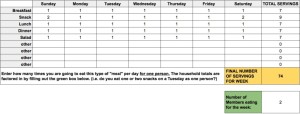So you’re ready to learn how to meal prep like a boss, eh? Well, you’ve come to the right place. Hopefully you’ve read our meal prepping story so you can see that it’s taken us a while to learn the ropes, which is why we want to save you the trouble of falling into the same traps we did. Now, we’ve got a lot to cover, so let’s jump in. Here’s our steps to meal planning like a BOSS:
Step 1: Determine your budget.
One of the biggest mistakes I made when I first started meal prepping was not understanding how much I had per week to spend on food. I was so used to spending like $50 per week on crappy food, that I really had no idea what it was going to take to upgrade my diet to a whole food, paleo diet. So, I sort of flailed for a couple of months until I figured out what it was I should be spending and – most importantly – how to stick to that budget once I set it, because it’s often difficult to determine how much things will cost at the store when you’re first setting out on this route.
We did a post a while back about how to stick to being paleo on a budget. I’d highly recommend giving that a read, because we’ve put all of our tips and tricks into that post, and they’re applicable whether you’re following paleo, AIP, or some other whole foods diet. Once you determine your budget and have a plan for sticking to it, you’re ready for Step 2.
Step 2: Determine how many meals you need to make.
Ok, this is a little deceiving because in reality, you’re going to be determining how many servings you need to make, not meals (i.e. different recipes). This was another big thing I had to figure out because before I did, I was cooking like 10 separate recipes per week, which was majorly time consuming and annoying. Once I had the realization that I just needed to determine how many portions I needed though, then I could double or even triple one recipe to help me get there, instead of trying to make 10 different dishes that each only served 4, for instance.
So what we do is we use a handy-dandy meal planning spreadsheet that we created, which looks something like this:
Get the full interactive spreadsheet here!
Here we’ve mapped out our needs for the week – how many breakfasts do we need, lunches, snacks, etc. From there, we can determine how many servings we are going to need for each meal/snack. Your serving sizes may look different than ours (and in all likelihood will), but you can use this as a template to chart out what you and your family’s food needs are for each week. Keep in mind this may change based on the number of people you’re feeding that week, if there’s any special occasions or holidays that week, etc.
Once you know your “magic number” of servings per week, you can start plotting out which recipes can help give you those particular number of servings each week. For us, doing this math ahead of time makes things a lot more clear and really streamlines the process of meal planning so that we’re not trying to make 3-4 different breakfast recipes each week; we can simply choose 1 or 2 and just make sure we’re adjusting the recipe(s) accordingly to fulfill our serving requirements.
Step 3: Find your recipes.
When looking for your recipes, I suggest doing a good ol’ fashion Google search for your AIP-friendly recipes, search on Pinterest, peruse AIP-friendly blogs & cookbooks (follow the link to find a great list of great bloggers and cookbooks) or use a tool like RealPlans.com (which is a godsend).
The other big tips I have to offer here is to consider two things when you’re choosing your recipes for the week:
1) opportunities to re-purpose the same ingredients, and
2) think about diversifying your cooking methods.
What I mean by #1 is, try choosing recipes that use similar ingredients so that you can buy those ingredients (particularly produce) in bulk. Repurposing ingredients also helps reduce food waste because – for example – you’ll be able to use that one bunch of cilantro in three different dishes, and you won’t have to throw it out because a recipe only calls for “2 tbsp chopped cilantro,” leaving you stuck with an entire bunch which is destined to go bad sitting in your refrigerator the rest of the week.
The second tip is about efficiency. If you’re trying to make six stovetop dishes during your meal prep cycle but you only have four burners, you’re going to find yourself wasting a lot of time standing around waiting for burners to open up. But, if you could have two dishes going on the stovetop at once, two dishes baking in the oven, and one going in the crockpot, then that’s a winning combination! So, keep that in mind when you’re choosing your recipes and try to pick a diverse range of cooking methods.
Step 4: Make your recipes (AKA do the work!).
This step sort of goes along with the above step, because it’s really about efficiency. Biggest tips here are to diversify your cooking methods, learn to multitask while cooking, try to have some fun, and get in the kitchen early! There’s nothing worse than it hitting 3pm on a Sunday when all you want to do is lay around in your sweatpants, only to realize you still have 2.5 hours of meal prep ahead of you. Get up, grab some tea, put some cool music on, and bust it out. Get the kids involved or ask your spouse to help out, make it fun – whatever you have to do. Just get it done so you can enjoy the rest of your day.
Other pro tips in this step include NOT trying to do everything in one day (we recommend pacing yourself by doing your planning/recipe selection one day, your shopping the next, and your batch cooking the day after that), and keeping a clean kitchen throughout the process (we recommend starting with an empty sink and dishwasher, and loading/hand-washing items as you go. That way, you aren’t left with a huge mound of dishes after a long batch cook session).
Step 5: Package up your meals.
One thing that really helps us as we embark upon our week as two adults working full-time jobs, is pre-packing and portioning our dishes. This helps us be able to just “grab and go” throughout the week, and packing our lunch boxes for each day is a cinch. We use these Pryex glass storage containers for any food that needs to be heated up, and we bought these BPA-free plastic storage containers for things that can be eaten cold (we try to avoid heating plastic unless we absolutely have to).
*Bonus Tip for Meal Planning Like a Boss:
RELAX. Sometimes (well, most times), meal planning can feel really overwhelming and daunting. The thing to keep in mind though, is that it’s all about your attitude. If you’re constantly allowing yourself to become stressed and get freaked out by meal planning, then it’s not going to go that smoothly. If you relax and accept the fact that dedicating 2-3 hours of your week helps you feel and perform your best though, then you’re going to be more successful.
In our household, we have fun with it. We enjoy going to Whole Foods and drinking a La Croix or tea while shopping around, talking with our local farmers at the farmer’s markets, and listening to music and being silly while we cook. I mean – we have to! To us, meal planning isn’t an option; it’s a necessity if you’re going to follow and be successful at paleo or especially AIP. So, might as well lean into it, instead of resisting it every step of the way.
So have fun, make mistakes, learn from them, fall down, pick yourself back up, and keep going until you find what works for you. You got this! After all, you are now officially a #mealplanningboss.









Thank you for this awesome two-part post on meal planning! I’ve been wanting to start batch cooking, but feeling unwell especially brain fog has made the task seem overwhelming – I just didn’t know where to start. But your well-organized, step-by-step instructions, plus tips and advice make it seem MUCH more possible now. I’m not sure I can adequately express my gratitude – again, many thanks!!
I certainly understand the woes of dealing with brain fog and trying to meal plan/prep! Glad to hear this has helped a bit – best of luck getting started and let us know if you have any further questions!
Great tips, Mitch! 🙂